Recent open access paper The ring sanctuary of Pömmelte, Germany: a monumental, multi-layered metaphor of the late third millennium BC, by Spatzier and Bertemes, Antiquity (2018) 92(363):655-673.
Interesting excerpts (emphasis mine):
In recent decades, evidence has accumulated for comparable enclosures of later dates, including the Early Bronze Age Únětice Culture between 2200 and 1600 BC, and thus into the chronological and cultural context of the Nebra sky disc. Based on the analysis of one of these enclosure sites, recently excavated at Pömmelte on the flood plain of the Elbe River near Magdeburg, Saxony-Anhalt, and dating to the late third millennium BC
The main occupation began at 2321–2211 cal BC, with the stratigraphically earliest features containing exclusively Bell Beaker finds. Bell Beaker ceramics continue after 2204–2154 cal BC (boundary occupation I/II), although they were probably undecorated, but are now complemented by Únětice Culture (and other Early Bronze Age) types. At this time, with features common to both cultures predominate. Only contexts dating to the late main occupation phase (late phase II) and thereafter contained exclusively Únětice Culture finds. Evidently, the bearers of the Bell Beaker Culture were the original builders of the enclosure. During a second phase of use, Final Neolithic and Early Bronze Age cultures coexisted and intermingled. The material remains, however, should not be taken as evidence for successive groups of differing archaeological cultures, but as witnesses to a cultural transition from the Bell Beaker Culture to the Únětice Culture (Spatzier 2015). The main occupation ended 2086–2021 cal BC with the deconstruction of the enclosure; Bell Beaker finds are now absent. Finally, a few features (among them one shaft) and radiocarbon dates attest the sporadic re-use of the site in a phase of abandonment/re-use that ended 1636– 1488 cal BC.
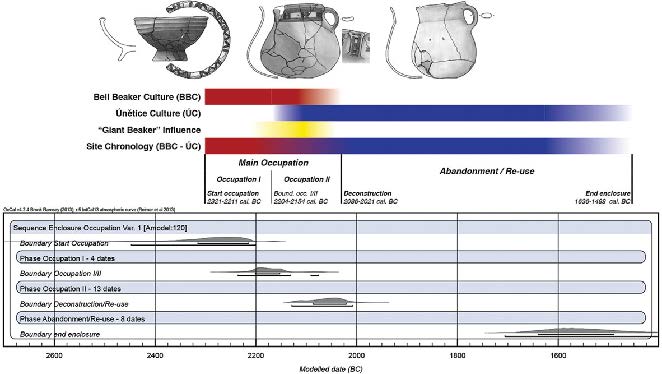
How the above-ground structures possibly influenced perception may reveal another layer of meaning that highlights social functions related to ritual. While zone I was disconnected from the surroundings by a ‘semi-translucent’ post-built border, zones II/III were separated from the outside world by a wooden wall (i.e. the palisade), and zone III probably separated individuals from the crowd gathered in zone II. Accessing the interior or centre therefore meant passing through transitional zones, to first be secluded and then segregated. Exiting the structure meant re-integration and re-connection. The experience possibly induced when entering and leaving the monument reflects the three stages of ‘rites of passage’ described by van Gennep (1909): separation, liminality and incorporation. The enclosure’s outer zone(s) represents the pre- and post-liminal phase; the central area, the liminal phase. Seclusion and liminality in the interior promoted a sense of togetherness, which can be linked to Turner’s “communitas” (1969: 132–33). We might therefore see monuments such as the Pömmelte enclosure as important communal structures for social regulation and the formation of identity.
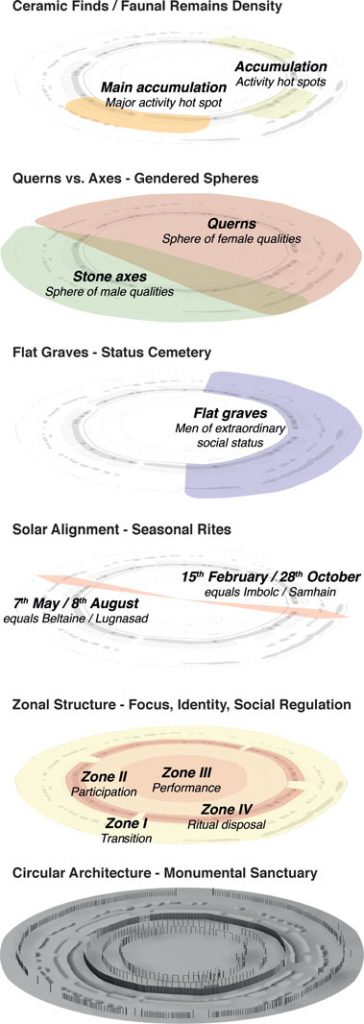
(…) The long-term stability of these connotations must be emphasised. As with the tradition of making depositions, these meanings were valid from the start of the occupation — c. 2300 BC — until at least the early period following the deconstruction event, c. 2050 BC. While the spatial organisation and the solar alignment of the main entrances were maintained throughout the main occupation, stone axes and ‘formal’ graves indicate the continuation of the spatial concepts described above until the twentieth to nineteenth centuries BC.
These layers of meaning mirror parallel concepts of space including, although not necessarily restricted to, the formation of group identities (see Hansen & Meyer 2013: 5). They can perhaps be better understood as a ‘cosmological geography’ manifested in the symbolism of superimposed levels of conceptual ideas related to space and to certain cardinal points (Figure 8). This idea is closely related to Eliade’s (1959: 29–36) understanding of “organized — hence comicized — territory”, that is territory consecrated to provide orientation within the homogeneity of the chaotic ‘outside world’, and the equivalence of spatial consecration and cosmogony. Put differently, the Pömmelte enclosure can be interpreted as a man-made metaphor and an icon of the cosmos, reflecting the Weltanschauung (a comprehensive conception of the world) of the people who built and used it. By bringing together Eliade and Rappaport’s ideas of meaningfulness in relation to religious experience (Rappaport 1999: 391–95), it may be argued that Pömmelte was a place intended to induce oneness with the cosmos. In combining multiple layers that symbolically represent different aspects of life (first-ordermeaning), the enclosure became an icon metaphorically representing the world (second-order-meaning). As this icon was the place to reaffirm life symbolism ritually, through their actions, people perhaps experienced a sense of rootedness in, or unity with, the cosmos (highest-order-meaning). Although we can only speculate about the perceptions of ancient people, such a theory aiming to describe general principles of religious experience can provide insight.
Conclusions
The circular enclosure of Pömmelte is the first Central European monumental complex of primarily sacred importance that has been excavated and studied in detail. It reveals aspects of society and belief during the transition from the Final Neolithic to the Early Bronze Age, in the second half of the third millennium BC. Furthermore, it offers details of ritual behaviour and the way that people organised their landscape. A sacred interior was separated from the profane environment, and served as a venue for rites that secured the continuity of the social, spiritual and cosmic order. Ancestor worship formed another integral part of this: a mound-covered burial hut and a square-shaped ditch sanctuary (located, respectively, within and near the enclosure’s south-eastern sector; cf. Figure 2)—dating to 2880–2580 cal BC and attributed to the Corded Ware Culture (Spatzier 2017a: 235–44)—suggest that this site was deliberately chosen. With construction of the ring sanctuary, this place gained an immense expansion in meaning—comparable to Stonehenge. Through architectural transformation, both of these sites developed into sanctuaries with increasingly complex religious functions, including in relation to the cult of the dead. The cosmological and social functions, and the powerful symbolism of the Nebra sky disc and hoard (Meller 2010: 59–70), are reflected in Pömmelte’s monumental architecture.
All of these features—along with Pömmelte’s dating, function and complex ring structure—are well documented for British henge monuments (Harding 2003; Gibson 2005). The continuous use of circular enclosures in Central Europe from around 3000– 1500 BC remains to be confirmed, but strong evidence indicates usage spanning from the fifth to the first millennia BC (Spatzier 2017a: 273–96). From 2500 BC onwards, examples in Central Europe, Iberia and Bulgaria (Bertemes 2002; Escudero Carrillo et al. 2017) suggest a Europe-wide concept of sanctuary. This indicates that in extensive communication networks at the beginning of bronze metallurgy (Bertemes 2016), intellectual and religious contents circulated alongside raw materials. The henge monuments of the British Isles are generally considered to represent a uniquely British phenomenon, unrelated to Continental Europe; this position should now be reconsidered. The uniqueness of Stonehenge lies, strictly speaking, with its monumental megalithic architecture.
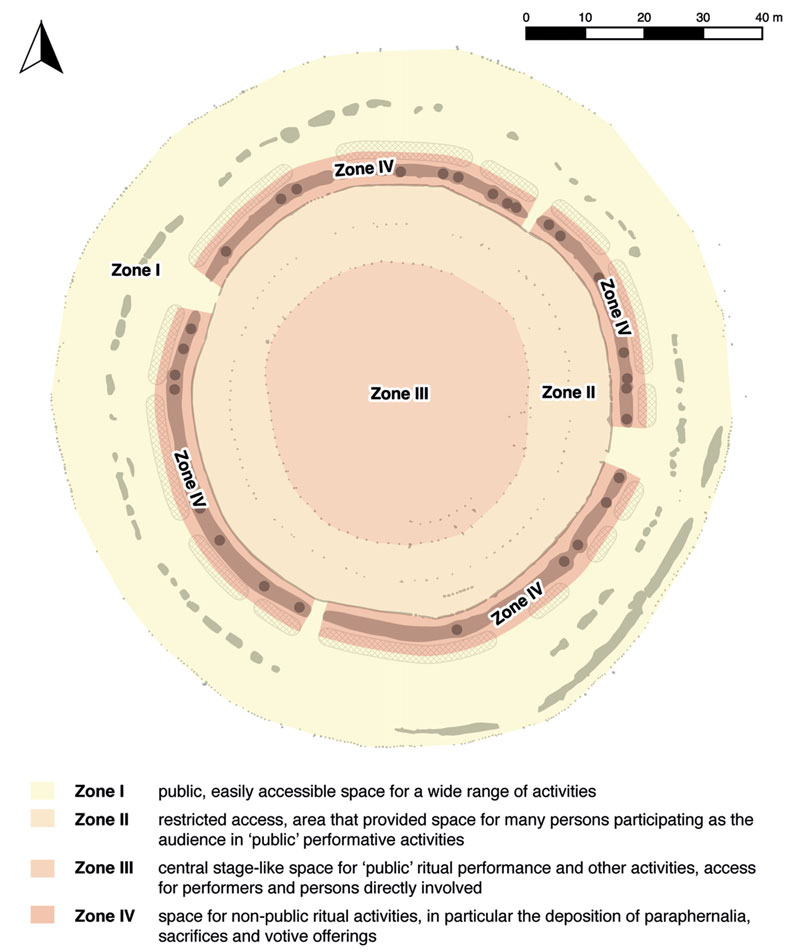
The Classical Bell Beaker heritage
No serious scholar can argue at this point against the male-biased East Bell Beaker migrations that expanded the European languages related to Late Proto-Indo-European-speaking Yamna (see David Reich’s comments), and thus most likely North-West Indo-European – the ancestor of Italo-Celtic, Germanic, and Balto-Slavic, apart from Pre-Celtic IE in the British Isles, Lusitano-Galician in Iberia, or Messapic in Italy (see here a full account).
With language, these migrants (several ten thousands) brought their particular Weltanschauung to all of Western, Central, and Northern Europe. Their admixture precisely in Hungary shows that they had close interactions with non-Indo-European peoples (genetically related to the Globular Amphorae culture), something that we knew from the dozens of non-Indo-European words reconstructed exclusively for North-West Indo-European, apart from the few reconstructed non-Indo-European words that NWIE shares with Palaeo-Balkan languages, which point to earlier loans from their ancestors, Yamna settlers migrating along the lower Danube.
It is not difficult to imagine that the initial East Bell Beaker group shared a newly developed common cosmological point of view that clashed with other neighbouring Yamna-related worldviews (e.g. in Balkan EBA cultures) after the cultural ties with Yamna were broken. Interesting in this respect is for example their developed (in mythology as in the new North-West Indo-European concept) *Perkwūnos, the weather god – probably remade (in language as in concept) from a Yamna minor god also behind Old Indian parjányas, the rain god – as one of the main gods from the new Pantheon, distinct from *Dyēus patēr, the almighty father sky god. In support of this, the word *meldh-n- ‘lightning’, behind the name of the mythological hammer of the weather god (cf. Old Norse Mjǫllnir or Latvian Milna), was also a newly coined North-West Indo-European term, although the myth of the hero slaying the dragon with the magical object is older.

Circular enclosures are known in Europe since the Neolithic. Also, the site selected for the Pömmelte enclosure had been used to bury Corded Ware individuals some centuries before its construction, and Corded Ware symbolism (stone axe vs. quern) is seen in the use given by Bell Beakers and later Únětice at this place. All this and other regional similarities between Bell Beakers and different local cultures (see here an example of Iberian Bell Beakers) points to syncretism of the different Bell Beaker groups with preceding cultures in the occupied regions. After all, their genealogical ancestors included also those of their maternal side, and not all encountered males disappeared, as is clearly seen in the resurge of previous paternal lineages in Central-East Europe and in Scandinavia. The admixture of Bell Beakers with previous groups (especially those of similar steppe-related ancestry from Corded Ware) needs more complex analyses to clarify potential early dialectal expansions (read what Iosif Lazaridis has to say).
The popular “big and early” expansions
These syncretic trends gave rise to distinct regional cultures, and eventually different local groups rose to power in the new cultural regions and ousted the old structures. Social norms, hierarchy, and pantheons were remade. Events like this must have been repeated again and again in Bronze and Iron Age Europe, and in many cases it was marked by a difference in the prevailing archaeological culture attested, and probably accompanied by certain population replacements that will be seen with more samples and studies of fine-scale population structure.
Some of these cultural changes, marked by evident haplogroup or admixture replacement, are defined as a ‘resurge’ of ancestry linked to previous populations, although that is obviously not equivalent to a resurge of a previous cultural group, because they usually represent just a successful local group of the same supraregional culture with a distinct admixture and/or haplogroup (see e.g. resurge of R1a-Z645 in Central-East European Bronze Age). Social, religious, or ethnic concepts may have changed in each of these episodes, along with the new prestige dialect.
NOTE. A recent open access paper on two newly studied Middle Bronze Age inhumations from Stonehenge give an interesting idea of potential differences in social identities, in ancestry and geographic origin (which characterize ethnicity) may have been marked by differences in burial ceremonies: Lives before and after Stonehenge: An osteobiographical study of four prehistoric burials recently excavated from the Stonehenge World Heritage Site, by Mays et al. Journal of Archaeological Science: Reports (2018) 20:692-710.
This must have happened then many times during the hundreds (or thousands in some cases) of years until the first attestation of a precise ancient language and culture (read e.g. about one of the latest branches to be attested, Balto-Slavic). Ancient language contacts, like substrates or toponymy, can only rarely be detected after so many changes, so their absence (or the lack of proper studies on them) is usually not relevant – and certainly not an argument – in scholarly discussions. Their presence, on the other hand, is a proof of such contacts.
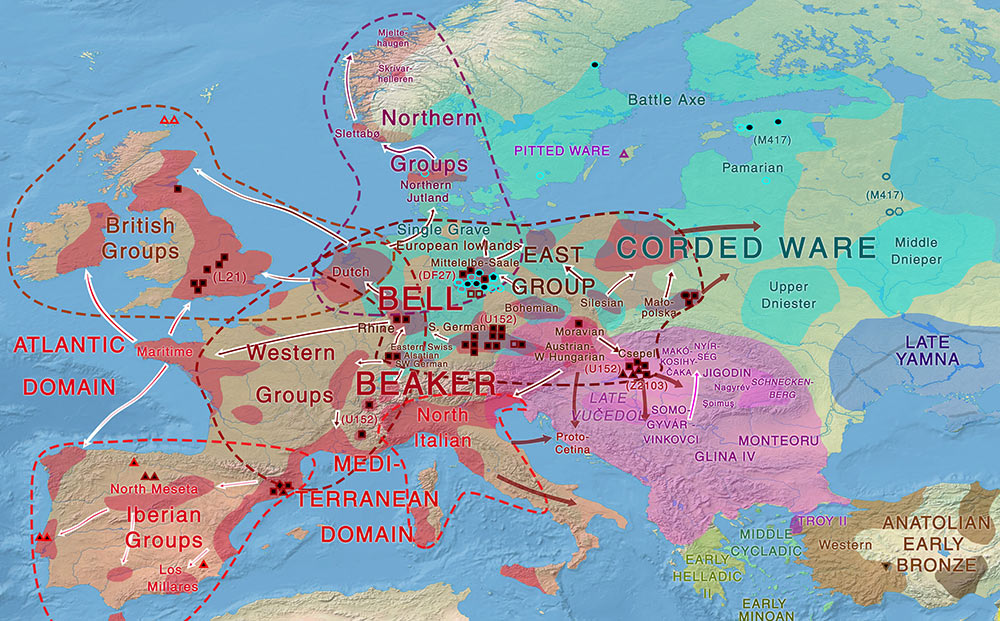
We have dozens of papers supporting Uralic dialectal substrate influence on Pre-Germanic, Proto-Balto-Slavic, and Pre- and Proto-Indo-Iranian (and even Proto-Celtic), as well as superstrate influence of Palaeo-Germanic (i.e. from Pre- to Proto-Germanic) and Proto-Balto-Slavic into Proto-Finno-Saamic, much stronger than the Indo-Iranian adstrate influence on Finno-Ugric (see the relative importance of each influence) which locates all these languages and their evolution to the north and west of the steppe (with Proto-Permic already separated, in North-East Europe, as is Proto-Ugric further east near the Urals), probably around the Baltic and Scandinavia after the expansion of Bell Beakers. These connections have been known in linguistics for decades.
Apart from some early 20th century scholars, only a minority of Indo-Europeanists support nowadays an Indo-European (i.e. centum) substrate for Balto-Slavic, to keep alive an Indo-Slavonic group based on a hypothetical 19th century Satem group; so e.g. Holzer with his Temematic, and Kortlandt supporting him, also with some supposed Indo-European substrate with heavy non-Indo-European influence for Germanic and Balto-Slavic, that now (thanks mainly to the views of the Copenhagen group) have been linked to the Corded Ware culture, as it has become clear even to them that Bell Beakers expanded North-West Indo-European.
NOTE. The Temematic etymologies have been (all of them) fully dismissed e.g. in Matasović (2013). I have already explained why an Indo-Slavonic group from Sredni Stog is not tenable, and genetics (showing Late PIE only from Yamna expansions) is proving that, too.
For their part, only a minority among Uralicists, such as Kuz’mina, Parpola or Häkkinen, believe in an ‘eastern’ origin of Uralic languages, around the Southern Urals. Genomic finds – like their peers – are clearly not supporting their views. But even if we accept this hypothesis, there is little space beyond Abashevo and related East Corded Ware cultures after the recent papers on Corded Ware and Fennoscandian samples. And yet here we are:
The Copenhagen “Homeland” interactive map
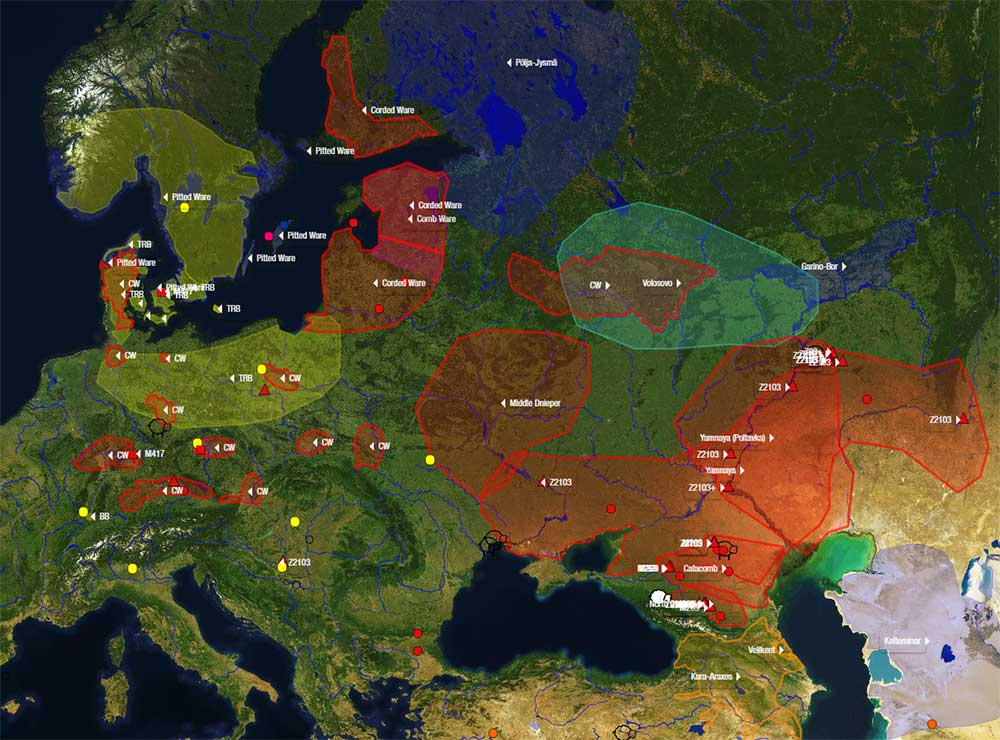
The new propaganda tool GIS timeline map of the Copenhagen group:
- consciously ignores Yamna settlers along the Danube, in the Balkans, and in Hungary, and initial East Bell Beakers, i.e. the obvious origin and expansion of North-West Indo-Europeans, but in contrast magnifies (and expands in time) regions for Sredni Stog / Corded Ware cultures (which suggests that this is yet another absurd attempt to revive the theories of the Danish school…);
- substitutes arrows for Kron-like colors (where danger red = Indo-European) with the same end result of many other late 20th century whole-Europe Kurgan maps, linking Sredni Stog and Corded Ware with Yamna, but obviating the precise origin of Corded Ware peoples (is it Sredni Stog, or is it that immutable Middle Dnieper group? is it West Yamna, or Yamna Hungary? is it wool, or is it wheels?);
- relegates Uralic speakers to a tiny corner, a ‘Volosovo’ cultural region, thus near Khvalynsk/Yamna (but not too much), that miraculously survives surrounded by all-early-splitting, all-Northern Eneolithic Indo-Europeans, thus considering Uralic languages irrelevant not only to locate the PIE Urheimat, but also to locate their own homeland; also, cultures identified in color with Uralic speakers expand until the Iron Age with enough care not to even touch in the map one of the known R1a samples published to date (because, for some people, apparently R1a must be Indo-European); and of course N1c or Siberian ancestry are irrelevant, too;
- and adds findings of wheels and wool probably in support of some new ideas based on yet another correlation = causation argument (that I cannot then properly criticize without access to its reasoning beyond cute SmartArt-like symbols) similar to their model – already becoming a classic example of wrong use of statistical methods – based on the infamously named Yamnaya ancestral component™, which is obviously still used here, too.
The end result is thus similar to any other simplistic 1990s Gimbutas (or rather the recently radicalized IE Sredni Stog -> Corded Ware -> BBC version by the Danish workgroup) + 2000s R1a-map + 2010s Yamnaya ancestry™; but, hard to believe, it is published in mid-2018. A lot of hours of senseless effort, because after its publication it becomes ipso facto outdated.
For comparison of Yamna and Bell Beaker expansions, here is a recent simplistic, static (and yet more accurate) pair of maps, from the Reich Lab:
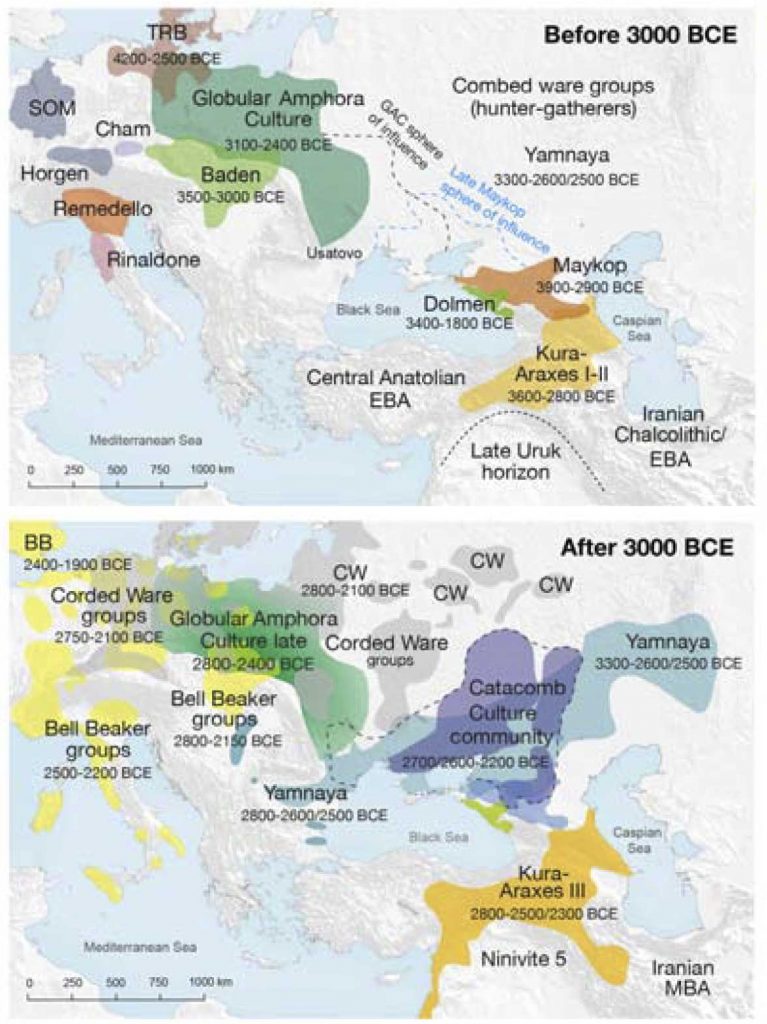
If the Copenhagen group keeps on pushing Gimbutas’ long ago outdated IE Sredni Stog -> Corded Ware theory as modified by Kristiansen, with their recently invented Corded Ware -> Bell Beaker model in genetics, at some point they are bound to clash with the Reich-Jena team, which seems to have less attachment to the classic Kurgan model and the wrong interpretations of the 2015 papers, and that would be something to behold. Because, as Cersei would say: “When you play the game of thrones, you win or you die. There is no middle ground.” And when you play the game of credibility, after so many, so wrong publications, well…
NOTE. I have been working on a similar GIS tool for quite some time, using my own maps and compiled genetic data, which I currently only use for my 2018 revision of the Indo-European demic diffusion model. Maybe within some weeks or months I will be able to publish the maps properly, after the revised papers. It’s a pitty that so much work on GIS and analysis with genetic data and cultural regions has to be duplicated, but I intend to keep some decent neutrality in my revised cultural maps, and this seems impossible at this point with some workgroups who have put all their eggs in one broken basket…
Related
- About Scepters, Horses, and War: on Khvalynsk migrants in the Caucasus and the Danube
- Steppe and Caucasus Eneolithic: the new keystones of the EHG-CHG-ANE ancestry in steppe groups
- The Caucasus a genetic and cultural barrier; Yamna dominated by R1b-M269; Yamna settlers in Hungary cluster with Yamna
- Consequences of Damgaard et al. 2018 (I): EHG ancestry in Maykop samples, and the potential Anatolian expansion routes
- Consequences of Damgaard et al. 2018 (II): The late Khvalynsk migration waves with R1b-L23 lineages
- No large-scale steppe migration into Anatolia; early Yamna migrations and MLBA brought LPIE dialects in Asia
- Early Indo-Iranian formed mainly by R1b-Z2103 and R1a-Z93, Corded Ware out of Late PIE-speaking migrations
- On the potential origin of Caucasus hunter-gatherer ancestry in Eneolithic steppe cultures
- Eneolithic Ukraine cultures of the North Pontic steppe and southern steppe-forest, on the Left Bank of the Dnieper
- North Pontic steppe Eneolithic cultures, and an alternative Indo-Slavonic model
- The concept of “Outlier” in Human Ancestry (III): Late Neolithic samples from the Baltic region and origins of the Corded Ware culture
- New Ukraine Eneolithic sample from late Sredni Stog, near homeland of the Corded Ware culture
- The renewed ‘Kurgan model’ of Kristian Kristiansen and the Danish school: “The Indo-European Corded Ware Theory”